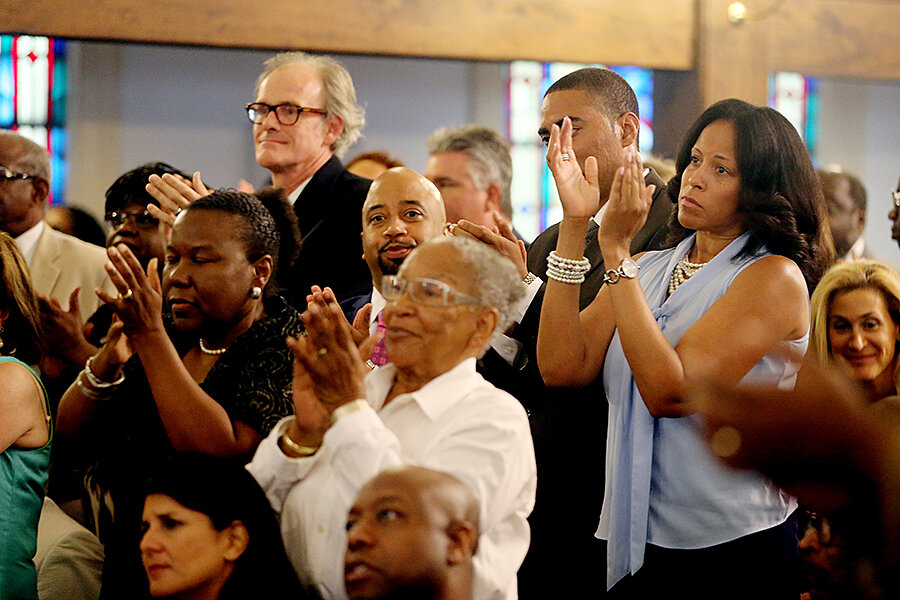Charleston shooting: for 'Mother Emanuel,' a central role in black struggle
Loading...
The sacred space on Calhoun Street in Charleston, S.C. – a place where black Christians have come for more than a century to worship God with exuberant, joyful praise – had already been built on a history of suffering and blood.
Born within the violence of America’s racist past, “Mother Emanuel,” the longest-standing African Methodist Episcopal congregation in the South and one of the oldest in the country, was an early-19th-century center for the black struggle. Since 1816, the church has witnessed its members hanged for resisting slavery, its first sanctuary burned to the ground by a white mob, its gatherings banned by official laws.
Yet the congregation continued to meet secretly for decades, as ancient Christians and those in communist states once did. After the Civil War, members finally rebuilt – a new two-story house of worship in 1872. Fourteen years later, however, the wood-frame sanctuary collapsed during the devastating earthquake of 1886.
On Wednesday, as members met to study God’s word in the basement of their current landmark church, a young man sat with members for nearly an hour before standing, declaring he was there “to shoot black people,” and opening fire, said law enforcement, citing eyewitnesses. Nine people were killed, including the church’s pastor, the Rev. Clementa Pinckney, who was also a state senator.
“Churches such as Emanuel were born both as symbols of spiritual freedom as well as political freedom,” says Randal Jelks, professor of African-American studies at the University of Kansas in Lawrence and an expert in the intersection of race and religion. “So to make an attack on this church – a full-scale terrorist attack, which is what this was – it’s an attack on a symbol of black freedom.”
The suspect, identified by law enforcement as Dylann Storm Roof, reportedly wore white supremacist symbols before Wednesday’s shooting. “I have to do it,” he said, according to a cousin of the pastor’s, who spoke with survivors of the attack. “You rape our women and you’re taking over our country. And you have to go.”
Shootings by disaffected and troubled young white men have become a frequent occurrence in the United States: Eric Harris and Dylan Klebold in Columbine, Colo.; Jared Lee Loughner in Tucson, Ariz.; and Adam Lanza in Newtown, Conn., to name just a few.
The massacre in the Charleston church, however, carries a different kind of shock and sorrow – given both the history of Mother Emanuel and the current political struggle, often called the “Black Lives Matter” movement, as black men have died at the hands of police officers.
The seeds for Mother Emanuel were planted in 1791, during the era of “the segregated altar”: A group of slaves and free blacks worshiped under the auspices of Charleston's Methodist Episcopal Church, a white denomination that provided the group’s ministers. But in 1816, when the white congregation decided to use the black members’ segregated burial grounds to erect a new building, they broke away, joining the nascent movement of black Christians that would become the African Methodist Episcopal Church.
One of the new congregation’s founding members, Denmark Vesey, a slave of a slave trader, organized a major slave revolt. City officials crushed the rebellion before it began, hanging Vesey and at least 34 others. The incident sparked other violence, and a white mob burned the church – and eventually, officials banned independent black churches outright in Charleston.
But the Civil War changed the landscape for such bans. And during Reconstruction, black congregations rose once again.
“The black church is also a symbol of the civil rights struggle that was birthed in the 1950s,” says Professor Jelks, who is also an ordained clergyperson in the Presbyterian Church (USA). “The centers of the black freedom struggle were always black churches, so this attack reminds people of those past struggles.”
Now, Emanuel is also a center for Charleston’s upper-middle-class black residents, Jelks says. “The American dream has always been to join the middle class, to have a little small piece of the pie,” he says, adding that in many ways, this shooting felt like an attack on black success in America.
Two years ago, Mr. Pinckney, who died in the basement of Emanuel on Wednesday, told a group of doctoral students meeting in the sanctuary that they were in “a very special place in Charleston. It’s a very special place because this site, this area, has been tied to the history and life of African-Americans since about the early 1800s.”
“What our church and our denomination stands for ... [is] the universal vision of all people being treated fairly under the law, as God sees us in his sight,” the pastor added.








